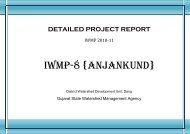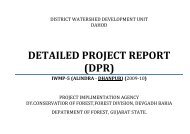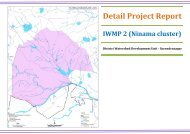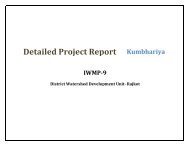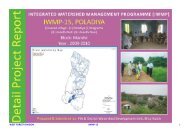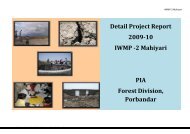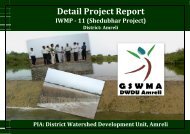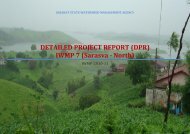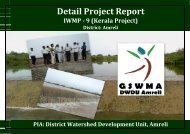Detailed Project Report - Commissionerate of Rural Development ...
Detailed Project Report - Commissionerate of Rural Development ...
Detailed Project Report - Commissionerate of Rural Development ...
Create successful ePaper yourself
Turn your PDF publications into a flip-book with our unique Google optimized e-Paper software.
District Watershed <strong>Development</strong> Unit - Jamnagar<br />
1. Boulder Checks<br />
Boulder checks or gully plugs are loose rock dams made on small drainage lines or seasonal streams which have a catchment area <strong>of</strong> less<br />
than 50 ha. It is adopted where the water velocity is high and where basically stone available with in radius <strong>of</strong> 100-150 m from the site. The main aim <strong>of</strong><br />
constructing loose boulder checks is to reduce the velocity <strong>of</strong> water flowing through the drainage line. By reducing the velocity <strong>of</strong> run<strong>of</strong>f, boulder checks<br />
help in:<br />
1. Reducing soil erosion;<br />
2. Trapping silt which slows the rate <strong>of</strong> siltation in water harvesting structures in the lower reaches <strong>of</strong> the watershed.<br />
3. Creating a hydraulic head locally which enhances infiltration <strong>of</strong> surface run<strong>of</strong>f into the groundwater system; and<br />
4. Increasing the duration <strong>of</strong> flow in the drainage line. Therefore, the capacity <strong>of</strong> the water harvesting structures created downstream on the drainage line<br />
is utilized more fully as they get many more refills.<br />
2. Gabions<br />
Gabion structures are rock and wire dams constructed across drainage lines with a catchment area <strong>of</strong> 50-500 ha. They are also constructed to reinforce<br />
highly erodible stream embankments. The main aim <strong>of</strong> constructing gabion structures is to reduce the velocity <strong>of</strong> water flowing through the drainage<br />
line. By reducing the velocity <strong>of</strong> run<strong>of</strong>f, gabion structures help in<br />
1. Reduction in soil erosion<br />
2. Trapping silt, which reduces the rate <strong>of</strong> siltation in water harvesting structures in the lower reaches <strong>of</strong> the watershed.<br />
3. Increasing recharge <strong>of</strong> groundwater and<br />
4. Increasing the duration <strong>of</strong> flow in the drainage line. Therefore, the capacity <strong>of</strong> the water harvesting structures created downstream on the<br />
drainage line is utilized more fully as they get many more refills.<br />
Drainage line Treatment and water harvesting:<br />
The second tier treatment is the slope treatment. This is generally agricultural land or waste lands. These are generally water conservation or<br />
surface water storage structures. These being highly labour intensive will involve more <strong>of</strong> manual labour so schemes like National <strong>Rural</strong><br />
<strong>Detailed</strong> <strong>Project</strong> <strong>Report</strong> – IWMP-1 (Patan )



